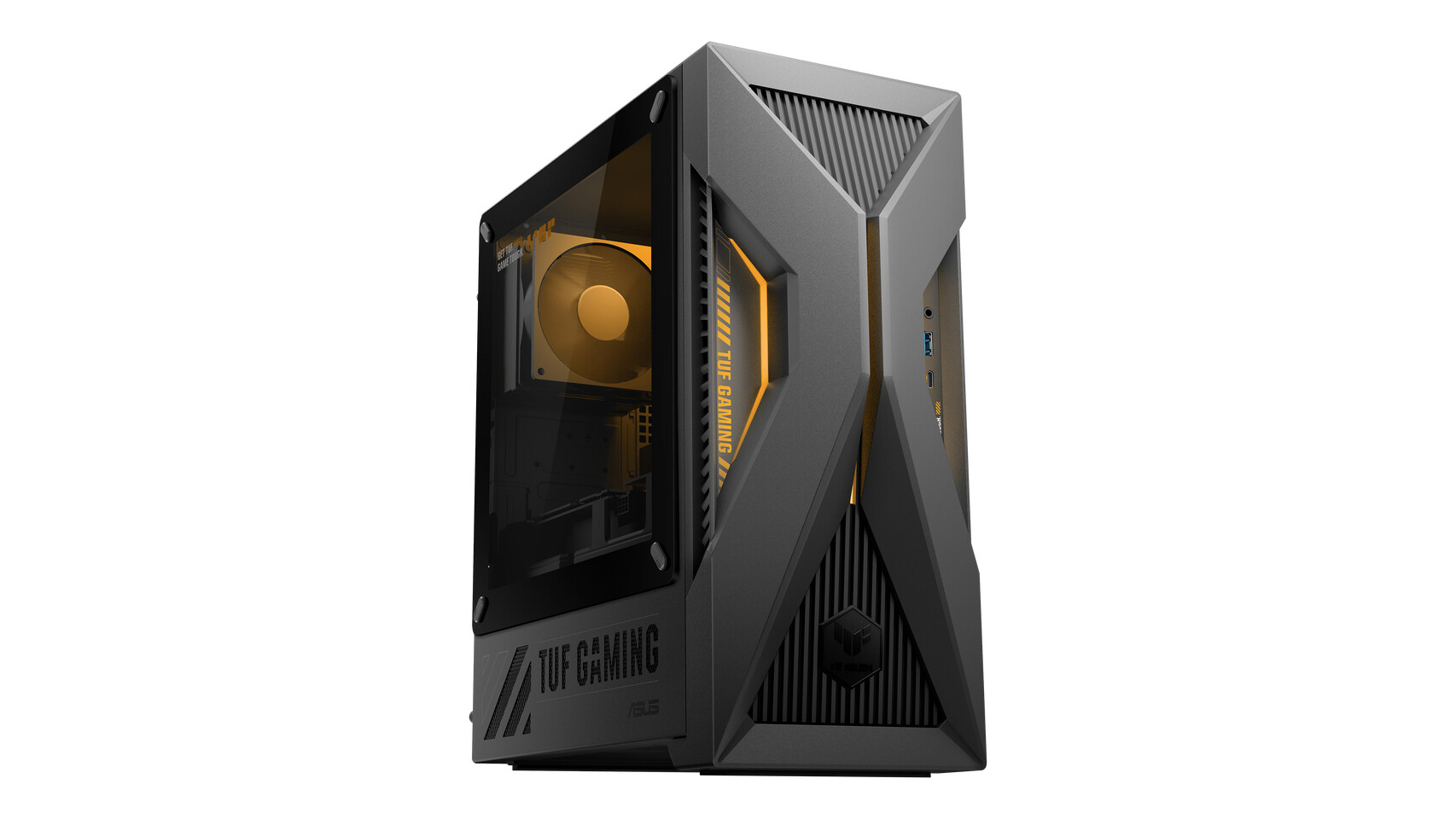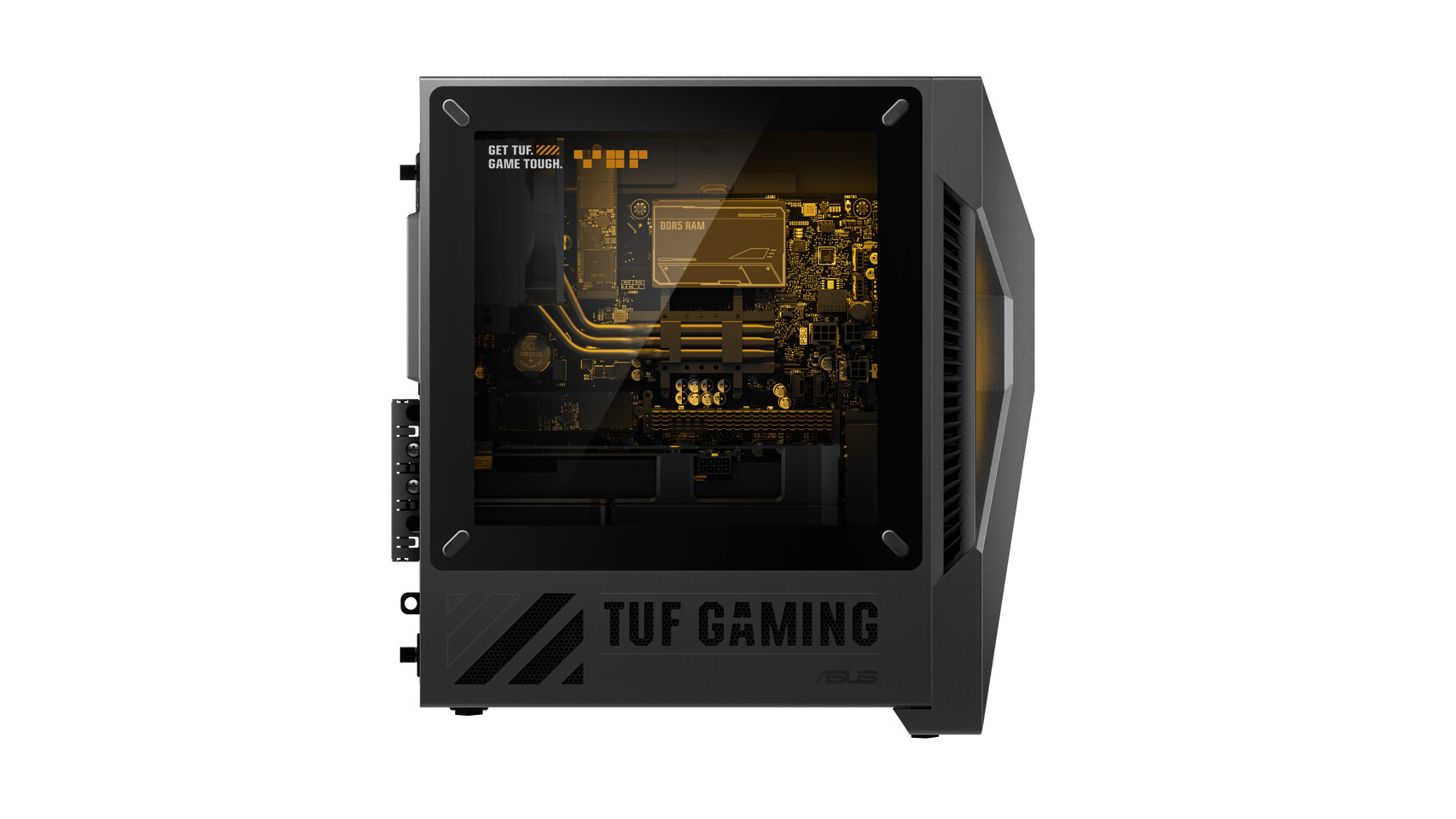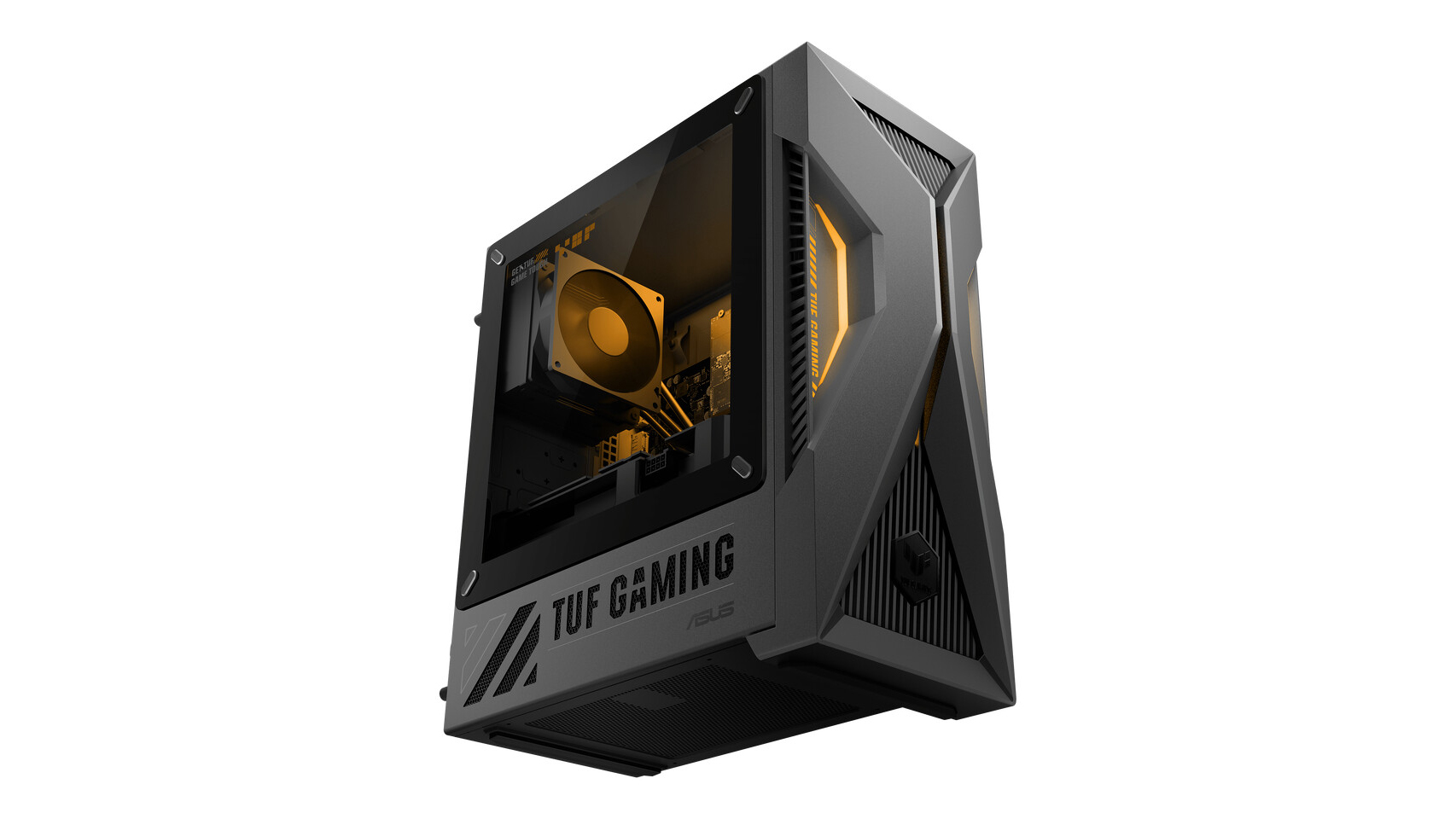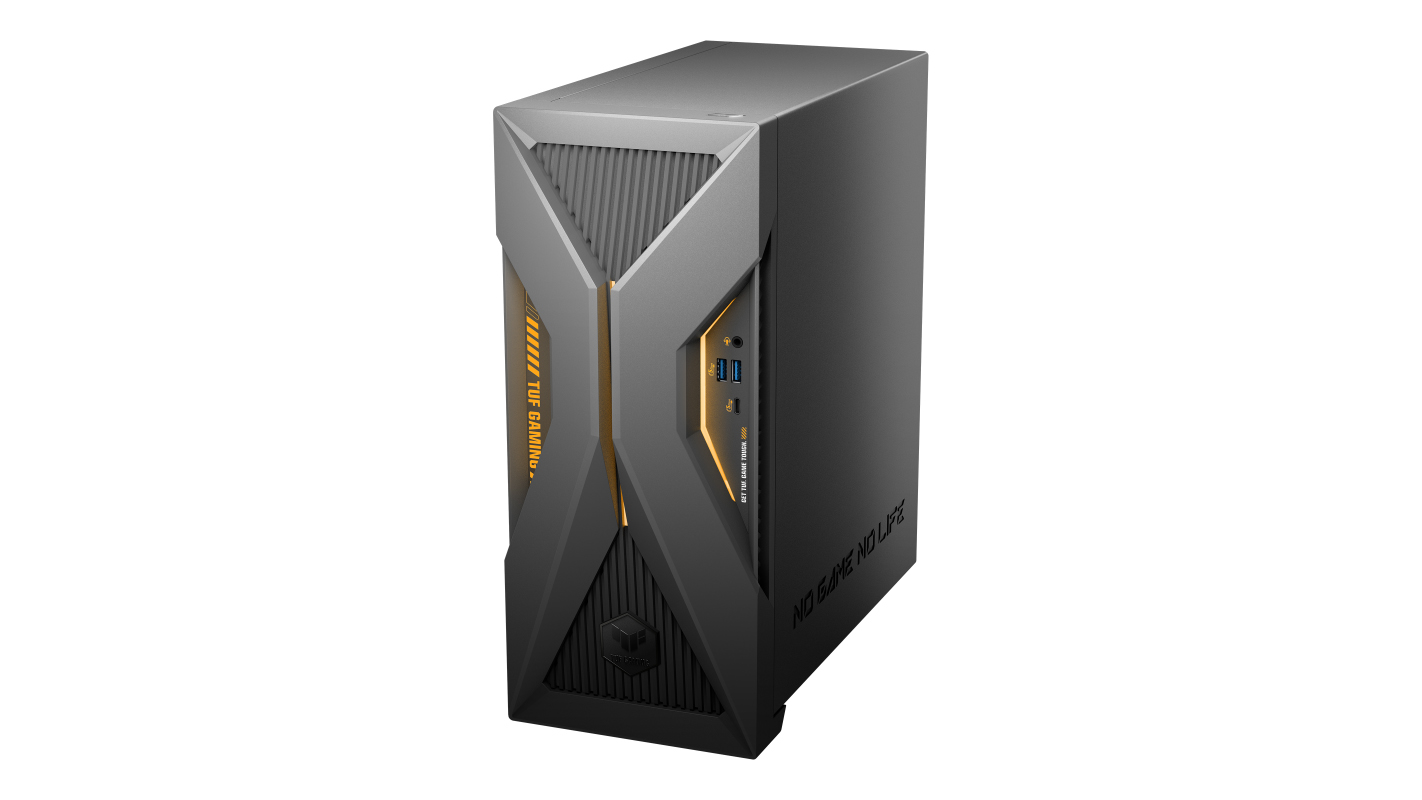Gaming desktop with a mobile CPU — Asus tries a different approach with the TUF Gaming T500
The TUF Gaming T500 pairs laptop-class Intel chips with Nvidia's RTX desktop GPUs

Asus has announced the new TUF Gaming T500 desktop, a small form factor PC for gamers. Unlike most traditional desktops, this compact PC is built around Intel’s mobile-class CPUs. Per the product page, the T500 can be configured with up to an Intel Core i7‑13620H, a 13th‑gen H‑series laptop chip with 6 performance, 4 efficiency cores, 16 threads, and boost clock speeds of 4.9GHz.
Asus claims that the T500 delivers “desktop-level gaming performance with much lower temperatures " by using this mobile CPU in a desktop chassis. That’s understandable, as laptop processors often run hot due to the cramped thermal constraints of a laptop chassis. However, heat should be far less of a concern in a full-sized desktop tower with better airflow and cooling potential.
On that note, the chassis features a rugged industrial design accented by RGB lighting on the front and offers users the choice between a tempered glass or solid side panel. Asus has equipped a custom air cooling setup for the mobile CPU, including a heatsink with a 90 mm fan and three heat pipes running across the processor. Based on its design, the cooler appears capable of keeping temperatures in check and maintaining high performance without thermal throttling.



The T500 is also available with a lower-tiered Core i5-13420H, an octa-core laptop CPU. As for the graphics, Asus quotes up to Nvidia RTX 50‑series graphics with the highest configuration, including a desktop dual-fan RTX 5060 Ti with 16GB of VRAM. The desktop will also be available with an RTX 5060 8GB, RTX 4060 8GB, or an RTX 3050 6GB.
The system has 16GB of DDR5 SO-DIMM memory at 5200 MT/s, but it can be upgraded to 64GB. For storage, there is the option of either a 512GB or 1TB of PCIe Gen 4 SSD along with a secondary M.2 slot, giving the option of adding a second SSD.
In terms of connectivity, the front I/O includes a USB 3.2 Gen 1 Type-C port and two USB 3.2 Gen 1 Type-A ports plus an audio jack, while the rear panel offers four USB 2.0 Type-A ports, 7.1 analog audio jacks, DisplayPort 1.4 and HDMI 1.4 video outputs, and a Gigabit Ethernet jack. Wireless networking is handled by Wi-Fi 6 and Bluetooth 5.4. A 500-watt 80+ Platinum power supply comes pre-installed, while the base system comes with a 330-watt unit.
The TUF Gaming T500's use of a laptop CPU in a desktop setup follows the growing trend of smaller, more power-efficient gaming PCs. This design could be a good fit for gamers who want a compact build or lower power usage. However, those chasing top-tier CPU performance might find the mobile chip doesn't quite match high-end desktop processors. Asus hasn't confirmed pricing or availability yet, but the official product page lists the desktop at $1,299.
Get Tom's Hardware's best news and in-depth reviews, straight to your inbox.
Follow Tom's Hardware on Google News to get our up-to-date news, analysis, and reviews in your feeds. Make sure to click the Follow button.

Kunal Khullar is a contributing writer at Tom’s Hardware. He is a long time technology journalist and reviewer specializing in PC components and peripherals, and welcomes any and every question around building a PC.
-
Notton This desktop mATX box has sooooooooooo much wasted potential while costing a pretty penny...Reply
It uses a custom CPU heatsink, reminiscent of Shuttle Cubes, but doesn't do anything useful with the space savings. Instead they opted to slap on some decoration.
I'm not against MoDT, but that heatsink design limits the cases this mobo can be used in.
If you look at the pictures, the heatsink doesn't even line up properly with the rear exhaust vent.
The mATX case looks bog standard, except it's not and uses a TFX PSU.
It's hard to see, but the mobo looks like it has some connectors for ATX 12VO, but not all of them...
I don't even know what's going on with the upper SSD slot. It extends far beyond the mobo and there is a proprietary mounting hole cut into the case just for the SSD.
If it's going to be this proprietary, why not put the GPU on a riser, sandwich style, and reduce the case volume?
Maxsun executes this idea better with their YTX form factor mobos.
Framework and minisforum design a better MoDT that work with standard ATX parts.
Did Asus lose its top design talent or something? because this monstrosity doesn't deserve the TUF branding. -
Pierce2623 Reply
To be fair virtually all MoDT systems use custom heatsinks because of the shelf coolers aren’t available for a random BGA “sockets”.Notton said:This desktop mATX box has sooooooooooo much wasted potential while costing a pretty penny...
It uses a custom CPU heatsink, reminiscent of Shuttle Cubes, but doesn't do anything useful with the space savings. Instead they opted to slap on some decoration.
I'm not against MoDT, but that heatsink design limits the cases this mobo can be used in.
If you look at the pictures, the heatsink doesn't even line up properly with the rear exhaust vent.
The mATX case looks bog standard, except it's not and uses a TFX PSU.
It's hard to see, but the mobo looks like it has some connectors for ATX 12VO, but not all of them...
I don't even know what's going on with the upper SSD slot. It extends far beyond the mobo and there is a proprietary mounting hole cut into the case just for the SSD.
If it's going to be this proprietary, why not put the GPU on a riser, sandwich style, and reduce the case volume?
Maxsun executes this idea better with their YTX form factor mobos.
Framework and minisforum design a better MoDT that work with standard ATX parts.
Did Asus lose its top design talent or something? because this monstrosity doesn't deserve the TUF branding. -
Notton Reply
Yes, except the MoDT mobos that come with a custom heatsink usually don't limit you to a weird 90mm cooler.Pierce2623 said:To be fair virtually all MoDT systems use custom heatsinks because of the shelf coolers aren’t available for a random BGA “sockets”.
They usually use a 120mm down draft cooler so it has wide compatibility.
And MoDT usually fits within the confines of a desktop heatsink mounting holes.
see here: https://www.maxsun.com/products/modt-12450h-itx-wifiand https://www.techpowerup.com/335886/minisforum-showcases-f1fgm-modt-motherboard-with-ryzen-9-9955hx-at-japan-it-week
The only exception is Ryzen AI Max 385/390/395+.
Everyone else using a weird custom mounting pattern is well... lazy. -
Amdlova Intel cpus and chipset it's way cheaper than AMD ones...Reply
One H670 motherboard, five Cpu's upgrades and Four graphics cards... and barely scrach my wallet
And will resell it to the next gen intel cpus without droop the price. -
VizzieTheViz This case seems big enough and spacious enough to support a cooler for a regular desktop cpu.Reply
I don’t really see why you would want modt if the resulting system is as large as a system you could build with regular desktop components.
Just seems like a lot of hassle and expense if you ever want to change or upgrade anything.
To my mind modt has its use, but that use is getting REALLY compact desktop pcs, not having something the size of a small desktop pc that performs worse.